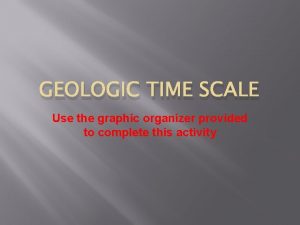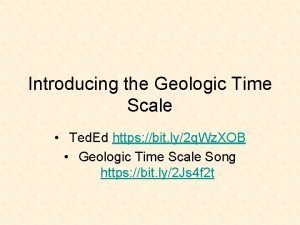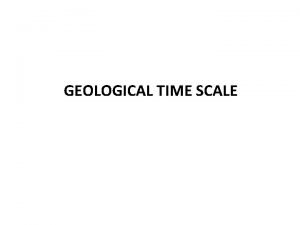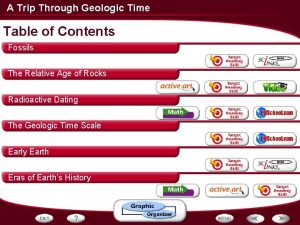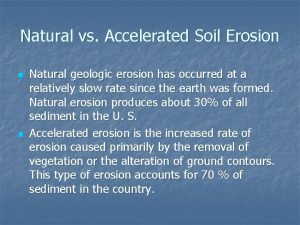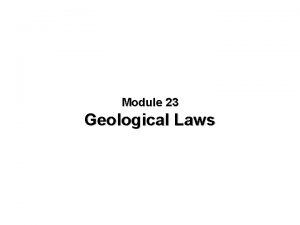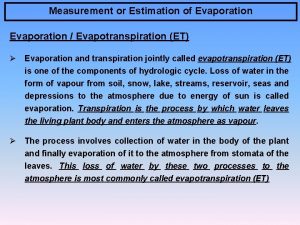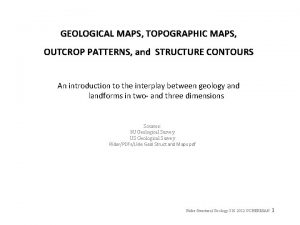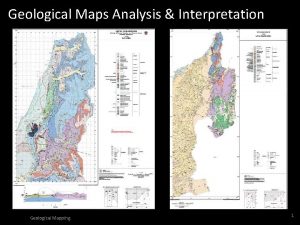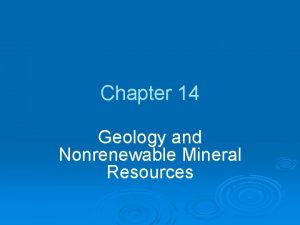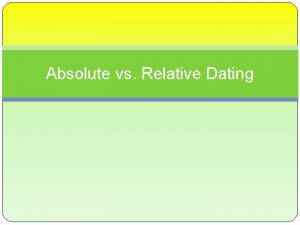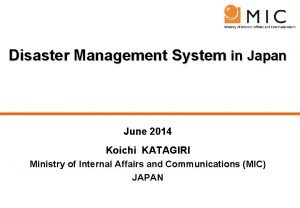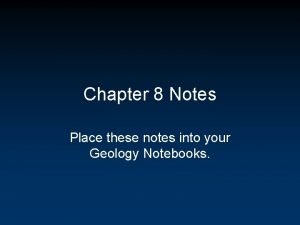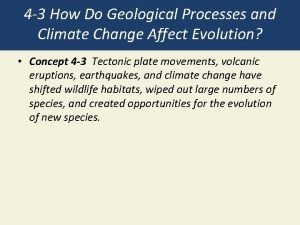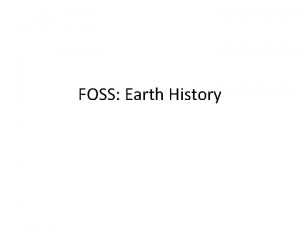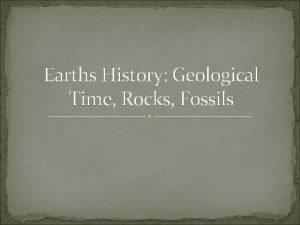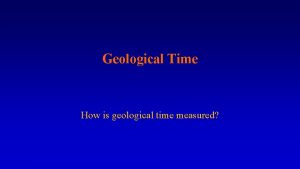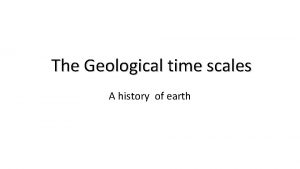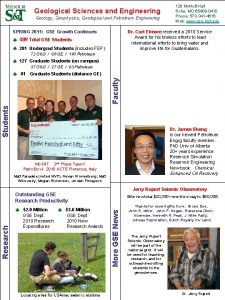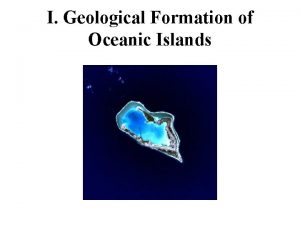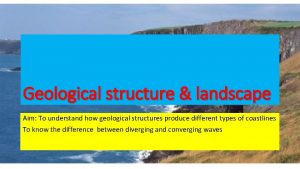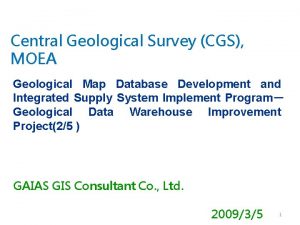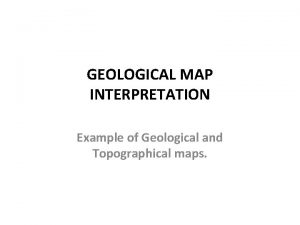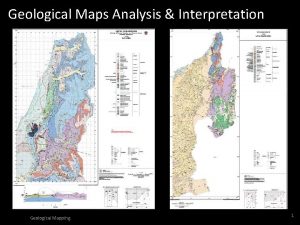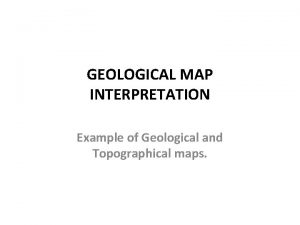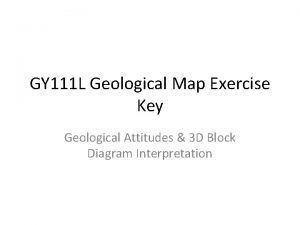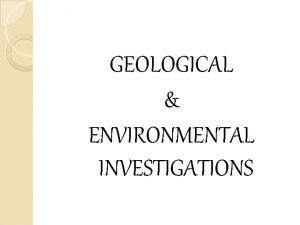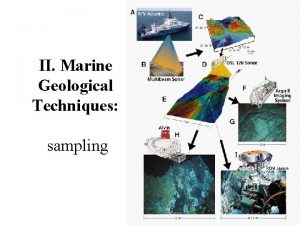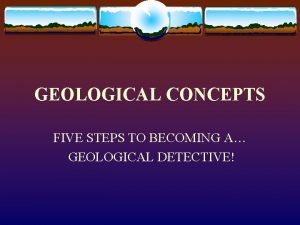FOSS Earth History Geological Time The earth is






























- Slides: 30

FOSS: Earth History

Geological Time • The earth is estimated to be about 4. 5 billion years old. Our knowledge of its history comes from a number of sources. The geologic time scale is constructed through scientific methods and calculations as well as from the interrelationships of geological features as observed in the field. The principle of uniformitarianism (“the present is the key to the past”) is helpful in that we can accurately measure the rates of geologic processes we see today and apply them to the geologic past. • For example, we know layers of sediment build up on the ocean floor at the rate of about 1 millimeter per year. Thus, it would take over one million years of sedimentation to form a unit of shale 1, 000 meters thick.

Evidence of the dynamic changes of Earth’s surface through time is found in the geologic record. Earth is approximately 4. 6 billion years old. Earth history is based on observations of the geologic record and the understanding that processes observed at present day are similar to those that occurred in the past (uniformitarianism). There are different methods to determine relative and absolute age of some rock layers in the geologic record. Within a sequence of undisturbed sedimentary rocks, the oldest rocks are at the bottom (superposition). The geologic record can help identify past environmental and climate conditions.

Uniformitarianism “the present is the key to the past” • the concept that the earth's surface was shaped in the past by gradual processes, such as erosion, and by small sudden changes, such as earthquakes, of the type acting today.

Law of Superposition • the principle that in any sequence of sedimentary rocks which has not been disturbed, the oldest strata lie at the bottom and the youngest at the top

Law of Crosscutting • if a fault or other body of rock cuts through another body of rock then it must be younger in age than the rock through which it cuts and displaces.

These are thin syenite dikes that cut a fine-grained gabbro, clearly after the gabbro was solid.

The Law of Original Horizontality • layers of sediment were originally deposited horizontally under the action of gravity. • The forces of nature beat up on the earth and break it into small pieces (weathering), which then wash down rivers (erosion) to the ocean and settle out on the seafloor, in horizontal layers. Lots of exceptions here! i. e. sand may be deposited at angles up to 15 degrees.

Law of Lateral Continuity • states that layers of sediment initially extend laterally in all directions; in other words, they are laterally continuous. As a result, rocks that are otherwise similar, but are now separated by a a valley or other erosional feature, can be assumed to be originally continuous.








Geologists recognize two different kinds of time: relative time and absolute age. Relative time concerns the sequence of geologic events, and absolute age measurements concern the actual age of a rock or mineral.

Relative Dating • Principles Of Relative Age Relative dating doesn't really give us an actual 'age, ' but it does put things in sequential order. This allows geologists to determine the age of a rock or strata relative to another rock or strata. So instead of saying 'when' something happened, it puts events in the 'order' they happened. It's basically the difference between saying 'I'm 25 years old and my sibling is 20 years old' and 'I'm older than my sibling. ' Geologists use a variety of techniques, or principles, to determine the relative age of a rock unit.

Absolute Age • Absolute dating is the process of determining an approximate computed age in archaeology and geology. • Absolute dating provides a computed numerical age in contrast with relative dating which provides only an order of events.

Radiometric Dating • Geologists use radiometric dating to estimate how long ago rocks formed, and to infer the ages of fossils contained within those rocks.

Radioactive elements decay. The universe is full of naturally occurring radioactive elements. Radioactive atoms are inherently unstable; over time, radioactive “parent atoms” decay into stable “daughter atoms. ”

• When molten rock cools, forming what are called igneous rocks, radioactive atoms are trapped inside. Afterwards, they decay at a predictable rate. By measuring the quantity of unstable atoms left in a rock and comparing it to the quantity of stable daughter atoms in the rock, scientists can estimate the amount of time that has passed since that rock formed.

Radiometric Dating Carbon • http: //vertpaleo. org/The-Society/blogoldbones/Old-Bones-Blog/September 2013/Romancing-the-isotopes--radiometricdating. aspx

Luminescence Dating • thermoluminescence, emission of light from some minerals and certain other crystalline materials. The light energy released is derived from electron displacements within the crystal lattice of such a substance caused by previous exposure to high-energy radiation. Heating the substance at temperatures of about 450° C (842° F) and higher enables the trapped electrons to return to their normal positions, resulting in the release of energy. The intensity of the emission can be correlated to the length of time that a given substance was exposed to radiation; the longer the time allowed for the radiation to build up an inventory of trapped electrons, the greater the energy released. Because of this feature, thermoluminescence has been exploited as a means of dating various minerals and archaeological artifacts.

Thermoluminescence Dating • Video

Relative Age of Sedimentary Rocks • Website

• • Bracketing the fossils Fossils are generally found in sedimentary rock—not igneous rock. Sedimentary rocks can be dated using radioactive carbon, but because carbon decays relatively quickly, this only works for rocks younger than about 50 thousand years. • So in order to date most older fossils, scientists look for layers of igneous rock or volcanic ash above and below the fossil. Scientists date igneous rock using elements that are slow to decay, such as uranium and potassium. By dating these surrounding layers, they can figure out the youngest and oldest that the fossil might be; this is known as “bracketing” the age of the sedimentary layer in which the fossils occur.

Fun Facts About Ohio'S Geological History • Fun Facts About Ohio'S Geological History 1. The oldest exposed rocks found in Ohio were deposited here 470 million years ago. 2. Flint is the official gemstone of Ohio. It originated in sea sponges that fell to the sea floor in pre-historic times. The sponges' openings were filled with mud or sand then compressed over time. Flint was used by Native Americans to shape spear points, knives and other tools. 3. Want to collect a million seashells? Pick up a piece of limestone rock. Limestone was formed from the remains of seashells. Many prestigious and architecturally significant buildings and monuments in Ohio are made from limestone. 4. The trilobite Isotelus is Ohio's state fossil. Many states have a state fossil. 5. Sandstone found in Ohio's Berea layer of the earth is known for three amazing things. First, it holds oil between its course grains. (Oil is a substance formed by sea creatures that decomposed in the absence of oxygen. ) By 1886 more that 2, 000 wells were drilled in eastern Ohio. Second, sandstone is a perfect material to make grindstones. In the 1870 s, the Berea layer produced more than 75 percent of the world's entire supply. Grindstones were shipped to Australia, Japan and South America. Third, buildings throughout North American are made from this important stone.

Fun Facts About Ohio'S Geological History 6. More than 80 percent of the electricity Ohioans use is made by burning coal, a fossil fuel. 7. About 290 million years ago a huge rock from space cashed into what is now Adams County in southern Ohio, shattering rocks in a five mile diameter. Rock layers at the center were pushed into the earth and then bounced back up. Those formations are now a 1, 000 feet above their original position. 8. Much to the disappointment of grade-school dinosaur lovers everywhere in Ohio, the state can't boast of any dinosaur bones or fossils found here. During the age of dinosaurs, massive erosion occurred here, preventing bones from being buried and turning into fossils. But we have great trilobite fossils. 9. Mammoths and mastodons, two elephant-like creatures, roamed Ohio during the Ice Age. 10. The rare and endangered Lakeside Daisy grows in only a few locations near the Great Lakes shores of the United States and Canada. The plant can be seen at the Lakeside Daisy State Nature Preserve on the Marblehead Peninsula on Lake Erie. The flower grows on an alvar, a shallow soil system over limestone. • (SOURCE: Ohio Governor's Residence and Heritage Gardens; Geologic Walk Guide and Companion Educational Materials)

Ohio's Geologic Periods • http: //www. ohiohistorycentral. org/w/Ohio's_ Geologic_Periods? rec=1380
 Geologic time graphic organizer
Geologic time graphic organizer Rubric for designing geological time scale
Rubric for designing geological time scale Jurassic coast map
Jurassic coast map Geological time scale
Geological time scale Geological time scale with events
Geological time scale with events Geological time scale
Geological time scale Geological time scale graphic organizer
Geological time scale graphic organizer Shannon foss
Shannon foss Foss programfag
Foss programfag Bacsomatic
Bacsomatic Foss chemical interactions
Foss chemical interactions Attatchment theories
Attatchment theories Diana foss
Diana foss Hanne foss hansen
Hanne foss hansen Python foss
Python foss Combifoss
Combifoss Anna foss
Anna foss Plate tectonics vs continental drift
Plate tectonics vs continental drift Roman
Roman Differentiate between geological and accelerated erosion
Differentiate between geological and accelerated erosion Module 23
Module 23 Dharma wijewickreme
Dharma wijewickreme Geological map sweden
Geological map sweden Factors affecting evapotranspiration
Factors affecting evapotranspiration Steeply dipping beds
Steeply dipping beds Geological map interpretation
Geological map interpretation Geological processes
Geological processes Rock dating
Rock dating Geological disaster example
Geological disaster example Geological events
Geological events How do geological processes affect natural selection
How do geological processes affect natural selection
